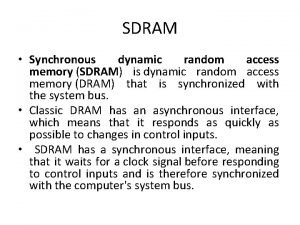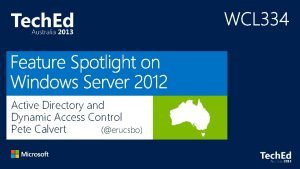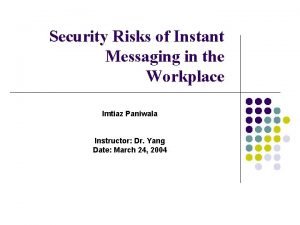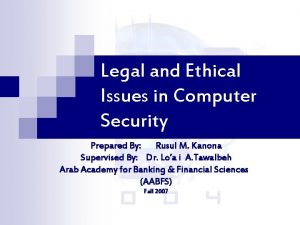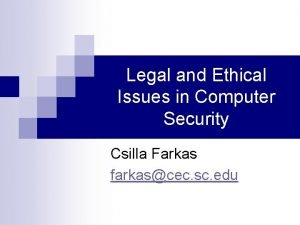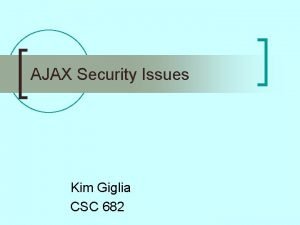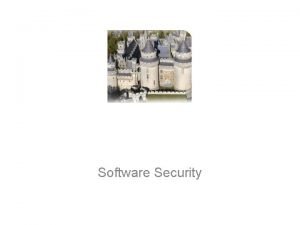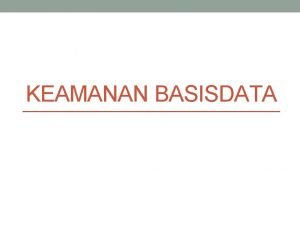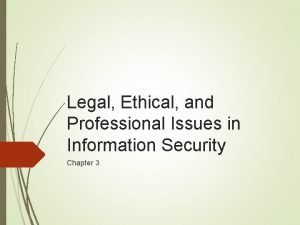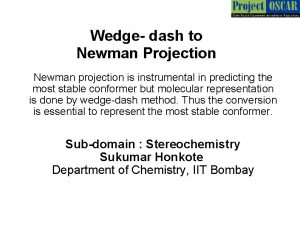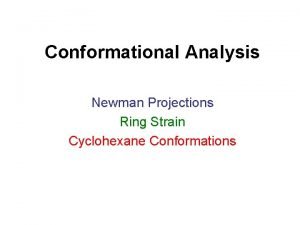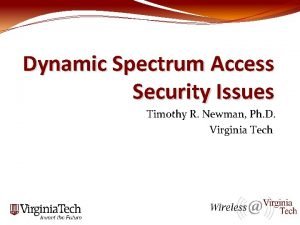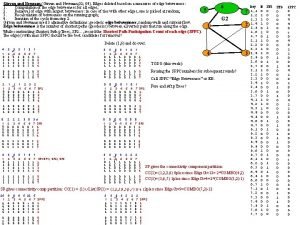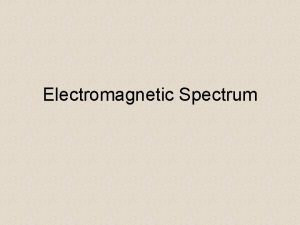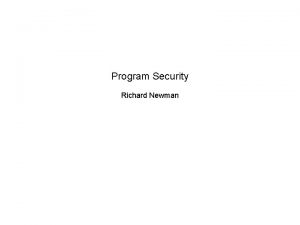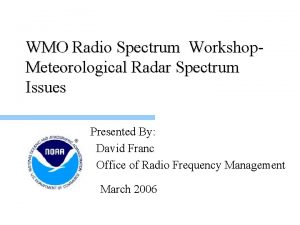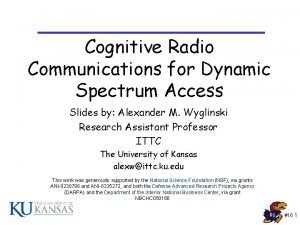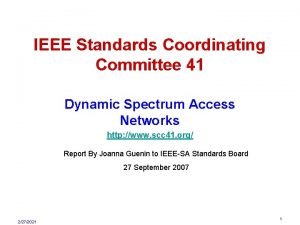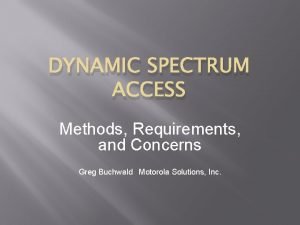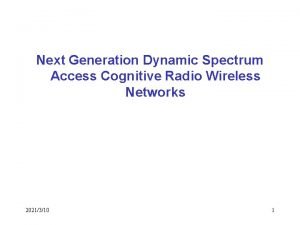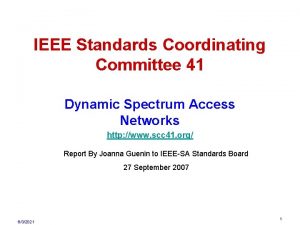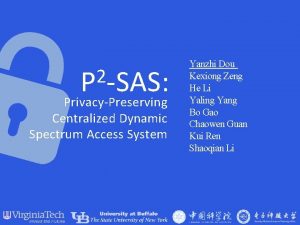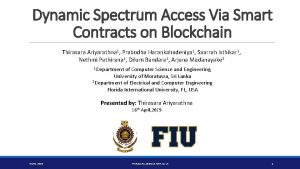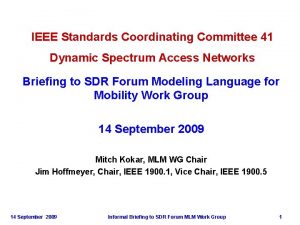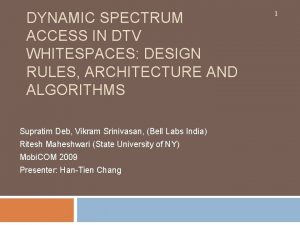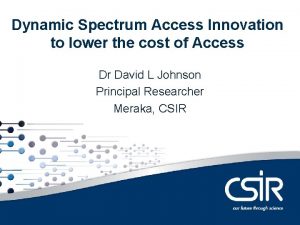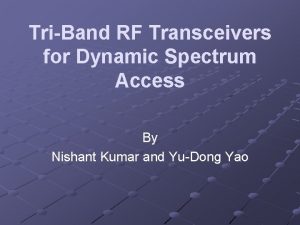Dynamic Spectrum Access Security Issues Timothy R Newman
































- Slides: 32

Dynamic Spectrum Access Security Issues Timothy R. Newman, Ph. D. Virginia Tech

Dynamic Spectrum Access �What is DSA? �Dynamically changing channel in response to environmental stimuli �Why do we want DSA? �Commercial: Inefficient spectrum usage �Military: Ease spectrum management tasks avoid jamming

DSA Current State �Where is DSA technology currently at? �DARPA XG radio program has come and gone � WNa. N program now pushing SOME development � No REAL deployment of these radios yet �Commercial companies now involved � Microsoft, Google, Dell HP, Intel, Philips, Samsung, …. � First “white space” network in Oct. 2009, Claudville, VA. � No adaptation but it’s a first step �Estimate at least 7 -9 solid prototype DSA systems exist

DSA Current State �Where is DSA technology currently at? (cont. . ) �Majority of the current prototype devices using energy detection techniques for signal detection �Final consensus – TRL 6 �What’s next for DSA? �Army purchase WNa. N radios for deployment? �SSC integrating DSA technology with ARGON’s Hy. NET wireless mesh network system (US Army) �Ultimate white space network deployed for WORLDWIDE broadband access!!!

Cognitive Radio and DSA Security �CR security is slowly coming into focus for academia and industry �SDR Forum session devoted to CR/SDR security �Publications with CR/SDR security topics are on the rise �Two DARPA programs on CR/SDR security proposed �Security research for CR/SDR is still largely overlooked �XG program had NO output related to security of DSA protocols �None of the current prototypes have any DSA specific security features

DSA Radio Security Analysis �What are the primary DSA security issues? �Primary User Emulation � Spoofing the intended primary user �Spectral Honey Pot threats � Forcing the victim DSA radio to operate on a specific channel �DSA Do. S threats � “I can sense and hop faster than you!”– PHY level threat � LPD jamming – Waveform level threat

Primary User Emulation �PUE threat is the baseline for many other DSA related attacks �Once you can manipulate the radio the floodgates are open, you’ve got root!! �Classifiers and Detectors are all over and have been for a long time �DSA brings a new twist – Detection/Classification affects communication parameters �Energy Detection is usually “settled” for to gain low complexity and processing speed �Problem now: Any error is a possible hole

Primary User Emulation

Primary User Emulation

Primary User Emulation �DSA algorithms commonly focus on maximizing Pd �Pd is probability the PU is detected when it is there �Pd = 100% is still not secure!! �This is what REALLY gets overlooked Remember XG Moto: “No Harm” This can guarantee no interference but can not guarantee security of DSA system

Spectral Honeypot �Objective is to manipulate a signal into a specific channel in order to have a better chance of exploitation �Simplistic approach will simple emulate a primary user until the user jumps to the target channel �Advanced approaches take advantage of the DSA algorithm by manipulating other portions of the environment

DSA Denial of Service �Straightforward DSA Do. S – Sense and Hop faster than the receivers �DSA radio networks must rendezvous on another channel if a PU appears �What if a PU appears before network can rendezvous? �Waveform level �Commonly DSA algorithm interleave the sensing and communication �Synchronize and jam only the communication time blocks

Analyzing a Real Radio! �Shared Spectrum DSA 2100 – Wi. MAX DSA Radio �Phase 3 contractor for DARPA XG Program �Interesting Radio Characteristics �Wavesat chipset: 802. 16 -2004 �Agility - 138 MHz – 3 GHz �Bandwidth - 1. 75 MHz, 3. 5 MHz, or 7 MHz �Tuning speed – 300 μs �TX spur level - -60 d. Bc �DSA Channel Selection Algorithms �Least occupied �Least energy �Random

Analyzing a Real Radio! �DSA Specific Parameters �Co-channel sample rate: 10 Hz �Non-occupancy period: 5 sec �Detection Algorithm: Energy detection �Freq. Range for analysis: 350 – 450 MHz, 400 – 480 MHz ** Non-occupancy period – Time a channel should be “blocked out” if a PU signal is detected

SSC Radio Tests �Analysis focused on DSA Do. S and spectral honeypot �PUE was a gimme! �How much Qo. S is degraded? �How fast can they be manipulated? �High Performance Tests �Done with a signal generator (Agilent) �Restricted to sweeping-type tests �Practical Tests �Done with GNUradio and USRP (RFX 400) �SDR enabled “smarter” tests

DSA Denial of Service �DSA Do. S = Never able to rendezvous �Signal generator parameters �Pulse sweep time - Amount of time pulse dwells in a channel before going to channel + 1 �Signal Power – Is the detection threshold really enforced? �Channel Step Size – 1 MHz (2 MHz probably would’ve been better)

DSA Denial of Service Non-Occupancy Period = 5 sec Spectrum Range = 100 MHz Sweep Rate = 100 ms 50 % Channels BLOCKED

DSA Denial of Service �Adding a bit of intelligence (sensing) �Using GNUradio we can easily put together a waveform that can sense the location of the signal and send a pulse �Pulse power only needs to be just above detection threshold �What happens if DSA radio ALWAYS sees a PU?

DSA Denial of Service �Sweeper �Pulse < 50 ms: pulse is going to fast �Theoretical optimal pulse sweep time = �Smarter Jamming �~92% packet loss �!100% because radio isn’t perfect ** Optimal = largest block size

Spectral Honeypot �Goal is to manipulate radio into using a specific channel �Signal Generator Sweep Method �Notch out a channel from the sweep list

Spectral Honeypot �Timing results for sweeper method

Spectral Honeypot �Timing results for sense and pulse

Security Analysis - Take Aways �What do we get from this analysis? �Motto of this specific DSA technology is “No Harm” � Focus is on existing systems Qo. S, not their own �No Harm to existing systems may mean ZERO communication for the DSA radios �Manipulation is possible when radios use an unauthenticated environment when making decisions �Non-occupancy period is a critical hole

DSA Security Mitigation �Primary User Emulation Denial �Signal Detection != Signal Classification � Robust classification is the objective � Unique feature selection is critical �Embed signatures � Watermarking techniques �Non-Occupancy Period �Randomize in order to create “holes” in the jamming block �Embedding “common sense” �Integrate security cognition into the system to filter for obvious malicious acts

Future Generation of CR Threats �Cognitive Radio technology is adding more autonomous operating into the wireless device �Increased exposure to possible threats �Threats to this technology is analogous to social networking attacks rather than traditional network attacks �Sensory Manipulation (DSA) �Belief Manipulation (Learning Attacks) �Cognitive Radio Viruses (Learning Network Attacks) �ETA until radios are using advanced AI: long…

Other SDR/CR related items at VT

Cognitive Radio Network Testbed �Defense University Research Instrumentation Program (DURIP) grant for CR testbed equipment. �Physical testbed deployed throughout a new campus building �Total size of testbed is 48 nodes � 12 nodes per floor �No restrictions on other wireless systems inside building �Reservation System for Nodes

CR Testbed Hardware Custom RF Daughterboard Host PC Servers � Motorola RFIC 4 � 100 MHz – 4 GHz � 20 MHz instantaneous bw � Highly variable receive gain � 25 d. B – 50 d. B � Multiple TX (3) and RX (5) paths � Sideband Rejection � 40 d. B - 60 d. B �Intel Xeon Quadcore 2. 13 GHz � 6 GB RAM, Gigabit Ethernet �Upgradable to Intel Nehalem for future �Much different from existing testbeds

Cognitive Radio Network Testbed �Current Testbed Status � 5 PC nodes with USRP and RFX 400 daughterboard �Power and network installed throughout building �Server’s are racked and ready �Waiting on USRP 2’s to be delivered �Management back-end is being developed

Cognitive Radio Open Source System � Open Source Cognitive Engine System API � Current reference implementation uses a Case-Based Reasoning Cognitive Engine � Radio Configuration described in XML � Application simply links to library to access system � Modular System � Cognitive Engines can be swapped in and out � Optional components � Policy Engine � Service Management Layer For more information: http: //cornet. wireless. vt. edu

Cognitive Radio Testbed � Modular architecture provides mechanism to simply “plug-in” components on remote systems where higher quality resources may be available Remote Access � Cognitive Engine developers can now focus on specific cognition algorithms � No more worrying about physical layer hardware issues Resource Rich Testbed

Cognitive Radio Open Source System � Integrated into both OSSIE and GNUradio for intelligent control of waveforms and applications � Demonstrated DSA application with “hot-swappable” cognitive engine � Service Management Layer component provides the service oriented architecture support � Manages services and capabilities provided to the cognitive radio by components � Translates radio missions into operations and instructions for CROSS components � Mission 1: Jam all enemy signals � Mission 2: Covert Jam Signals � Detect signals � Signal Classifications � Enemy using Wifi? � Optimize Power for jamming � Detect wifi channel � Jam signal � Jam Wifi � Monitor for resurgence on multiple channels
 Private securit
Private securit Chromium orbital configuration
Chromium orbital configuration Absorption spectrum
Absorption spectrum Digital access issues
Digital access issues Dynamic dynamic - bloom
Dynamic dynamic - bloom Synchronous dynamic random access memory
Synchronous dynamic random access memory Active directory dynamic access control
Active directory dynamic access control Terminal access controller access control system plus
Terminal access controller access control system plus Terminal access controller access-control system
Terminal access controller access-control system Sip security issues
Sip security issues Instant messaging security risks
Instant messaging security risks Ethical and professional issues in information security
Ethical and professional issues in information security Legal and ethical issues in computer security
Legal and ethical issues in computer security Attack sophistication vs intruder technical knowledge
Attack sophistication vs intruder technical knowledge Ajax security issues
Ajax security issues Software security issues
Software security issues Mengapa keamanan basis data menjadi penting.
Mengapa keamanan basis data menjadi penting. E commerce security and fraud issues and protections
E commerce security and fraud issues and protections Legal and ethical issues in information security
Legal and ethical issues in information security Trans decalin newman projection
Trans decalin newman projection Universidad san pedro chimbote
Universidad san pedro chimbote Projection quest
Projection quest What shapes internal structure
What shapes internal structure Margaret newman biography
Margaret newman biography Plymouth accommodation portal
Plymouth accommodation portal Hsc geography syllabus
Hsc geography syllabus Newman projections of cyclohexane
Newman projections of cyclohexane Cardinal newman cedar
Cardinal newman cedar Batasan perencanaan
Batasan perencanaan Gerald levey and mark newman
Gerald levey and mark newman Newman projection generator
Newman projection generator Barnett newman abraham
Barnett newman abraham Robert c newman ii
Robert c newman ii





